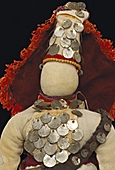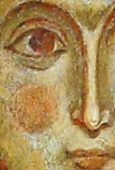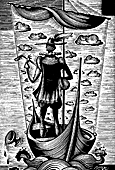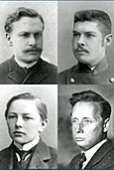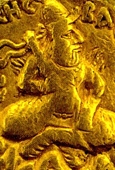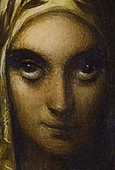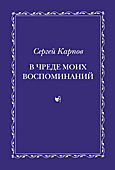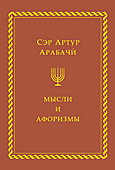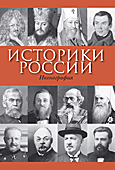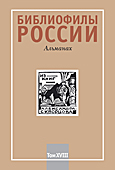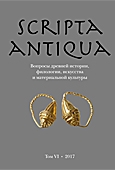Археология
Два богатых эллинистических погребения из могильник Псенафа
Эрлих В.Р.
В статье публикуются комплексы двух коллективных элитных погребений с лошадьми из некрополя IV в. до н.э. — I в. н.э. археологического комплекса Псенафа (Адыгея). Обнаруженные в погребениях предметы свидетельствуют как о высоком статусе погребенных, так и об обменных и торговых связях высших слоев меотского общества с Македонией, Восточным Средиземноморьем и кельтским миром. Анализ содержимого погребений, прежде всего привозных изделий, позволяет отнести их к первой половине II в. до н.э.
V.R.Erlikh (Moscow). TWO RICH HELLENISTIC
BURIALS FROM PSENAFA NECROPOLIS
This article presents two collective elite burials with horses from the Psenafa necropolis (Republic of Adygeya, IVth cent. BC — 1st cent. AD). The objects revealed in the graves demonstrate the high status of the interred persons, as well as exchange and trade relations of the upper strata of Maeotian society with Macedonia, the Eastern Mediterranean and the Celtic world. Analysis of the grave items, especially the imported goods, allows the author to date them to the first half of the 2nd century BC.
История Древнего Востока
Уникальная бронзовая композиция с джайной из канала Занг (Джаркурган, Сурхандарья)
Абдуллаев К.
Статья посвящена редкой находке художественной бронзы, найденной в Сурхандарьинской области на дне канала Занг. Композиция представляет собой изображение джайны Шветамбары, восседающем на троне на фоне своего небесного дворца. Иконографический анализ бронзовой скульптуры позволяет наметить близкий круг аналогий, распространенных на севере и западе Индии. Надпись на обратной стороне скульптуры письмом нагари дает приблизительную датировку предмета XII в. Одним из возможных путей попадания в Среднюю Азию можно назвать торговую деятельность индийских купцов, кварталы которых находились в крупных городских центрах Средней Азии, включая и Сурхандарью (Чаганиан).
K.Abdullaev (Istanbul, Turkey). THE UNIQUE BRONZE
COMPOSITION WITH JAINA FROM ZANG-CHANNEL (JARKURGAN, SURKHANDARYA)
The article is devoted to the rare discovery of bronze art found in Surkhandarya Region (Uzbekistan) in the bottom of the channel Zang. The composition represents an image of Jaina Švetambara, enthroned on the background of his heavenly palace. The iconographic analysis of the bronze sculpture allows identifying a close circle of analogies, common in northern and western India. The inscription on the reverse side in the letter Nagari gives to the sculpture an approximate dating to the XIIth century. One possible way to reach Central Asia could be trading activity of Indian merchants, whose quarters were in urban centers of the Central Asia, including Surkhandarya (Chaganian).
Заметки по хетто-лувийской социальной терминологии
Баюн Л.С.
В статье рассмотрена лексико-семантическая группа слов, которые являются продолжением индоевропейского возвратно-притяжательного местоимения *swe/o- ‘свой’. Материалом для исследования послужили письменные памятники хетто-лувийских языков середины — второй половины I тысячелетия до н.э. — лидийского и ликийского. Установлено, что развитие семантики производных лексем привело к появлению в этих языках ряда юридических терминов, терминов родства и, возможно, обозначения замкнутых социальных групп, восходящих к основе *swe/o-.
L.S.Bayun (Moscow). NOTES ON SOME
HITTITO-LUVIAN SOCIAL TERMS
The article deals with the lexical-semantic group of words that are derived from the Indo-European possessive pronoun *swe /o-, which in historical Indo-European languages gives a large number of cognates defining a person in a complex of economic, social, kinship and affectiveties. The study is based on the written records of Lydian and Lycian (Hittito-Luvian languages of mid. — 2nd part of I mill. BC.). It has been found that the semantic development of the relevant Lydian and Lycian derivatives led to the appearance of legal terms (e.g. Lyd. śfẽni- ‘property’, aśfã- ‘legal ownership’), those of kinship (Lyd. śfato-, Lyc. hberus(-) ‘-in-law’), as well as (tentatively) to the designation of a closed social community (Lyc. huwedri?).
История Древней Греции
О некоторых проблемах спартанского политогенеза (архаическая и классическая эпохи)
Суриков И.Е.
В первой части статьи автор пытается показать, что в процессе становления спартанского полиса все три главные политические силы (цари, аристократия, демос) объединились для достижения общих целей. Так называемая поправка к Великой ретре не имела, вопреки распространенному мнению, олигархического характера. Во второй части анализируется в спартанском контексте взаимоотношение военной активности и политических процессов. Автор приходит к заключению, что очень интенсивная военная история архаической Спарты создала, в конечном счете, «ликургов космос», а создание этого последнего повело, в свою очередь, к резкому уменьшению спартанского экспансионизма.
Третья часть статьи представляет собой «апологию Спарты», попытку хотя бы частично снять с нее ту «черную тень», которая нависла над ней в современной историографии. Автор полемизирует с представлением о Спарте как об агрессивном, тоталитарном «полицейском государстве».
I.E.Surikov (Moscow). ON SEVERAL PROBLEMS
OF THE STATE FORMATION IN SPARTA (ARCHAIC AND
CLASSICAL PERIODS)
The article is aimed at showing that during the process of emergence of the Spartan polis, all three main political forces (kings, aristocracy and the demos) were united to achieve some common aims. The so-called amendment to the Great Rhetra contra an influential opinion, was not a document of oligarchic character. The mutual relation of military activity and political developments is analyzed within the Spartan framework. The general conclusion is the following: very active military involvement of Archaic Sparta created in the long run the unique “Lycurgan cosmos”, and the latter’s creation led, in its turn, to rapid diminution of Spartan expansionism.
The last part of the article presents a kind of “apology of Sparta”, an attempt to free this polis (at least partly) of its “black shadow” so popular in the modern historiography. The author argues against the view of Sparta as an aggressive, totalitarian “police-state”.
История эллинистического мира
Aй-Ханум и Кампыртепа: культурные отношения и датировка
Ртвеладзе Э.В.
Статья посвящена сопоставлению археологических материалов двух эллинистических городищ на Оксе — Ай-Ханум и Кампыртепа, вопросам их культурных взаимоотношений и датировки. Автор на основании археолого-стратиграфических исследований Кампыртепа приходит к выводу, что культурный слой самого древнего, первого периода эллинистического Кампыртепа, датированный концом IV в.—235/230 гг. до н.э., отсутствует на Ай-Ханум. Для этого периода на Кампыртепа характерно применение в строительстве стен прямоугольного сырцового кирпича, тогда как в Ай-Ханум все сооружения возведены исключительно из квадратного кирпича. Судя по тем же археолого-стратиграфическим данным, квадратный кирпич на Кампыртепа появляется только во второй период эллинистической эпохи, датированный на основании монетных находок временем Евтидема (235/230–200 гг. до н.э.) и, возможно, несколько ранее. Следовательно, имеются все основания утверждать, что город-крепость Кампыртепа, вероятно, Александрия Оксианская, был возведен раньше, чем Ай-Ханум.
E.Rtveladze (Tashkent). AI KHANUM AND KAMPYRTEPA: СULTURAL RELATIONS, DATING
This paper is dedicated to the correlation of the archaeological assemblages from two Hellenistic sites on the river Oxus — Ai Khanum and Kampyrtepa, and to a range of questions of their cultural interaction and dating. Based on archaeological and stratigraphic investigations at Kampyrtepa the author concludes that the cultural layers of the first, the most ancient period of Hellenistic Kampyrtepa, dating from the end of the 4th century BC up to 235/230 BC, are lacking in Ai Khanum. This period for Kampyrtepa is characterized by the use of rectangular sun-baked-bricks in building construction, whereas at Ai Khanum all structures were built exclusively of square mud-bricks. Judging by the very same archaeological and stratigraphic evidence, square bricks came into use in Kampyrtepa only in the second building period of the Hellenistic epoch, which is dated by coins to the time of Euthydemus (235/230 — 200 BC) or, perhaps, a little earlier. Consequently, there are grounds for maintaining that the citystronghold Kampyrtepa, possibly Alexandria on the Oxus, was constructed earlier than Ai Khanum.
Легенда об основании Антиохии-на-Оронте
Смирнов С.В.
Статья представляет собой анализ легенды об основании Антиохии-на-Оронте – столицы государства Селевкидов, сохранившейся в сочинениях Либания и Иоанна Малалы. Сюжетная близость описания обоими авторами этого события позволяет говорить об общем источнике двух вариантов легенды, который мог быть создан под влиянием официальной царской идеологии. Совмещение идеи основания столицы и формирования династии, несомненно, приводит к мысли о восприятии Селевкидами региона Сирии в качестве центра своего государства и придания ему особого идеологического статуса.
S.V.Smirnov (Moscow). THE “FOUNDATION LEGEND” OF
ANTIOCH
The presented paper studies the legend of the founding of Antioch – the capital city of the Seleucid Empire, which was preserved in the works of Libanius and John Malalas. The close similarity of these versions allows us to expect the common source for both of these narratives, which in its turn could have been influenced by the Seleucid royal ideology. The very fact that the ideas of the founding of the capital city and the creation of a new dynasty were harmonized, leads us to the conclusion that Seleucids considered the region of Syria to be the center of their power and authority.
История Северного Причерноморья
Варварские племена, соседи греческих городов Боспора
Тохтасьев С.Р.
Автор анализирует лингвистические данные (преимущественно для VI–I вв. до н.э.), которые могут дать представление о языках народов, живших по соседству с Боспорским государством, или, начиная с 60-х гг. IV в. до н.э., находившихся под его властью. Обзор не претендует на полноту, автор сосредоточился на тех свидетельствах, которые с большей или меньшей определенностью атрибуируются тому или иному народу: это этнонимы; личные имена, этническая принадлежность носителей которых прямо указана в источниках или может быть установлена по иным данным и соображениям; топонимы, которые более или менее надежно локализуются на той или иной племенной территории.
S.R.Tokhtas’ev (St.-Petersburg). BARBARIAN TRIBES, NEIGHBOURS OF THE GREEK CITIES OF BOSPORUS
Author analyses linguistic data (mainly for VI–I centuries B.C.), which can shed some more light on the languages of the people, neighbors of Bosporan kingdom, or from the 60-ies of the IVth cent. B.C. — living under its power. The given review does not pretend to be exhaustive. The author focused on the testimonies, which can be more or less definitely attributed to a certain people: proper and ethnic names, whose ethnic attribution is either directly given in the sources or can be fixed according to other data and suggestions; place-names, which can be more or less precisely localized on a certain territory. Among the ethnic names the following are considered in a more detailed way: Μαιῶται (Μαιῆται in connection with the name of Maiotis), Σινδοί, Ψησσοί, Ζυγοί, Ζι(κ)χοί (inconnection with the ethnic name адыге), Σιρακ/χοί (Σίρακες), Ἰαζαμάται (Ἰαζαβάται, Ἰαξαμάται, Ἰξιβάται, Ἰξομάται и т.д.).
Иранские традиции в политике, идеологии и культуре Понтийского царства
Сапрыкин С.Ю.
В статье рассматриваются иранские традиции в политике, идеологии и культуре Понтийского царства. Автор отстаивает тезис о том, что первые Митридатиды выдвигали идею о наследственном праве владеть большей частью территорий в Анатолии и Даскилее, так как их предки Отаниды и ахеменидские сатрапы получили эти земли в наследственное владение от Дария I за помощь в ликвидации заговора псевдо-Смердиса (Гауматы). На этой идеологической парадигме выстраивалась их внешняя политика, которая видоизменялась в зависимости от внешнеполитической конъюнктуры, но по сути оставалась прежней. Вследствие того, что означенная версия рассматривалась как официальная, царская пропаганда Митридатидов использовала иранские традиции и культы эллинских богов для обожествления царей, чтобы идея о территориальном расширении царства «по-наследству от предков» получила в глазах подданных и союзников больший политический вес.
S.Yu. Saprykin (Moscow). IRANIAN TRADITIONS IN POLICY, IDEOLOGY AND CULTURE OF THE KINGDOM OF PONTUS
This article is a study of Iranian traditions in policy, ideology and culture (religion) of the Pontic kingdom (Pontic Cappadoce). The author is putting forward an idea that the early Mithridatids of Pontus created the ideological conception of their hereditary right “from the ancestors” to possess the greatest part of territories in Anatolia and Dascyleum. It was based on the fact that the Otanids (named after Otanes, one of the Seven Magi), their direct ancestors, and the Achaemenid satraps as relatives of the Otanids, had got these regions as hereditary land from Darius I for assisting him to suppress the plot, headed by pseudo-Smerdis (Gaumata). This ideological concept was used as background of foreign and internal policy, conducted by the Mithridatids of Pontus. It was mostly used in the early years of the Kingdom of Pontus when the first kings were fighting for independence against the Macedonian rulers and spread power to neighboring areas. But it was exposed to some changes after coming into close relations with the Seleucids and Rome, being impacted by political conjuncture. None the less this ideological version still remained as official, having been only slightly hidden under peaceful and friendly rhetoric. So far as the Pontic dynasts were trying to get sympathy of Anatolian and Hellenic population, necessary for successful expansion to the Black Sea and Western Anatolia, the so-called “royal propaganda” of the Mithridatids used the Greek and Anatolian cults for deifying their kingship, particularly of Mithridates VI. But the Iranian speaking inhabitants could easily identify these deities with the Iranian ones. Such ideological and religious transformation was due to the necessity of keeping on the ancient Iranian idea of hereditary power of the Mithridatids of Pontus over vast territories in Anatolia and the Black Sea.


